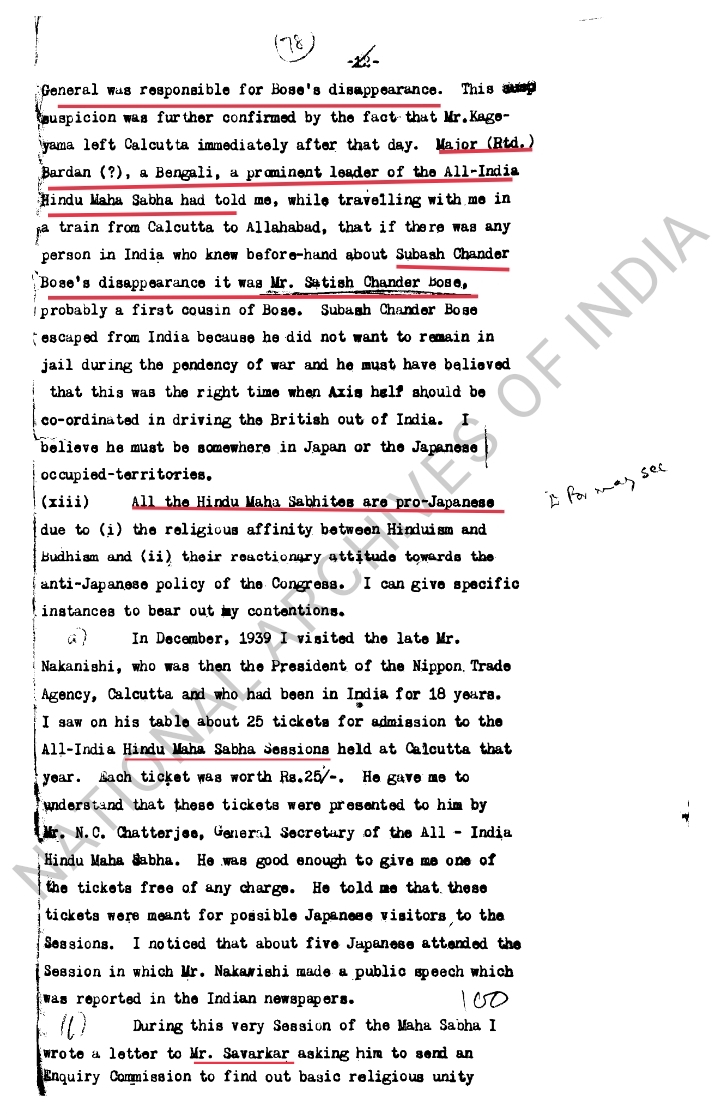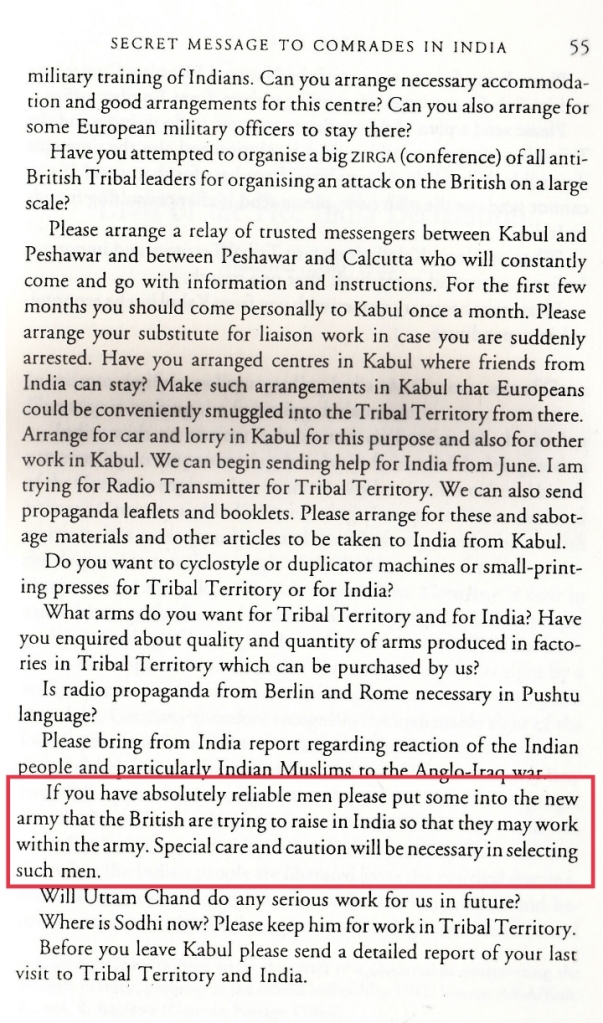Often people make some silly criticism that Savarkar turned British stooge & never engaged in any anti-British activity after his release from prison. Let’s check some facts.
Savarkar was released from prison in 1924, but was not fully released from house arrest until 1937.
There are several evidences that Savarkar communicate with Rash behari Bose.
Rash behari Bose’s letters to Revolutionary Sachindranath Sanyal in 1937, advises him to ask for help from Savarkar and Subhash Chandra Bose. (Documents are given below👇)


Source : Sanjeev Sanyal/Twitter
Rash behari Bose’s letter to Savarkar after his release from prison.👇




Source : Rash Behari Basu His Struggle For India’s Independence
by Sabitri Prasanna Chatterjee
The same book also narrates the communication between Savarkar and Rash behari Bose, and later the meeting with Subhash Bose, which led to the formation of the INA in 1943. Savarkar was the bridge between Rash behari Bose and Subhash Chandra Bose. 👇


Inspired by Savarkar, Rashbihari Bose establishes Hindu Mahasabha in Japan 👇

Source : Two Great Indian Revolutionaries
by Uma Mukherjee
Nehru Memorial & Museum Library has evidence of correspondence between Rash Behari Bose and Savarkar in the form of letters.


Source : Asianisms: Regionalist Interactions and Asian Integration

Source : The New Asia of Rash Behari Bose: India, Japan, and the Limits of the International, 1912-1945
Savarkar was the mediator between Netaji and Rash Behari Bose 👇


In 1940, a meeting between Subhash Bose and Savarkar takes place..In this meeting, Savarkar shows Netaji the letters which was sent by Rash behari Bose as evidence and asks him to form an army outside India with the help of Germany and Japan against Britain.👇


Source : The Two Great Indians In Japan
by Ohsawa J.g
On January 16, 1941, Subhash Chandra Bose, who was under house arrest, disappeared from India.
Netaji’s demise perturbed British intelligence and became one of the hotly debated issues of the time.
As early as 1940, the British Intelligence Bureau reports in the National Archives speak about the pro-Japanese stance of the Hindu Mahasabha. (Documents 👇)








Source : Click here to read documents
The report also states that Rash behari Bose requested the Delhi Hindu Mahasabha Secretary Indu Prakash through a letter to send the writings/literature related to the Hindu Mahasabha to Japan through Savarkar. 👇

Another important thing is the information related to Shankar Lal who was the forward bloc secretary (The party which formed by Subhash Chandra Bose).. He was a confidant of Netaji..This intelligence report of 1940 states that Shankar Lal entered Japan with a fake passport and after that Bose must have entered Japan through the same means.. (Documents 👇)


In another intelligence report in 1944, the IB reporter also testifies that Savarkar’s name was the most heard from Shankar Lal and his associates. According to the report, Savarkar pressured Bombay Chief Magistrate Mr. Mehta in favor of Shankar Lal in the case related to Shankar Lal’s fake passport.
Shankar Lal’s visit to Japan was the first step in Subhash Bose’s disappearance from India, the report says. (Document 👇)

Source : Click here to read documents
The report has more details on the relations between the Hindu Mahasabha, Netaji, Japan and Rashbehari Bose (Documents 👇)





According to another intelligence report of 1941, a letter from Delhi forward bloc secretary Mukandalal Sircar to Sarat Chandra Bose included a well-wishing note from Savarkar about Netaji…
It says:
“Wherever he happens to be, I have no doubt, he will continue to give his all, even his health and life, to the cause of Indian freedom.”


Source : Click here to read documents
All these evidences point to the fact that Savarkar knew Netaji’s disappearance from India in advance.
After 1940, many people accuse Savarkar for recruiting young men into the British Army during World War 2, and that was to help the British against Netaji.. Let’s see what the truth is.
From Savarkar’s own words 👇

Source : Hindu rashtra darshan
Here is the letter written by Rash Behari Bose, founding father of INA, to Subhas Chandra Bose in 1938.
The letter talks about the need for Indians to get military training. Also, it was suggested that the Congress should abandon non-violence and try to establish dominance in the military system. He mentions the activities carried out by former Hindu Mahasabha president Dr. Moonje in this area (establishment of military school etc.). At the end of the letter, again the proposal to dominate the military systems namely Army, Navy and Air Force is put forward.



Source : Collected works of Netaji Vol 9
Here is a message sent by Netaji to the comrades in India👇


Collected Works of Netaji Vol 11
The main purpose of militarisation is, to grab the opportunity to acquire training in modern weaponry during World War 2, which will be useful in the case of a future civil war, or armed revolution…
Savarkar later makes a request to recruit people from mahar community into the mahar regiment 👇

Source : Click here to read documents
Even Ambedkar was supportive for it and he appeals the youth to join the mahar regiment and make use of the opportunity 👇

Source:
Source : Dr. Ambedkar Life and Mission by Dhananjay Keer
Japanese author Ohsawa JG’s book indicates how Savarkar’s militarization policy benefited the INA. 👇

Source : The Two Great Indians In Japan
by Ohsawa J.g
INA – Savarkar – Hindu Mahasabha
It can be seen from the documents in the archives that the Hindu Mahasabha stood in support of the INA trials.
A 1945 intelligence report quoting a Mahasabha speaker in a lecture held as part of the Mahasabha’s INA week celebration says that a large number of people have joined Subhash Bose’s INA following the call of Savarkar and the Hindu Mahasabha, and if Britishers touch them, a bloody revolution will ne the end result.

Source : Click here to read documents
Also it is said in the same report that it has been decided to send a petition to the UNO under the leadership of the Hindu Mahasabha to ensure justice for the INA soldiers and to draw world attention to this issue. 👇

Another report also mentions the amount collected by the Hindu Mahasabha for the INA Relief Fund. 👇

Source: Click here to see documents
The most important is an archival file about the INA in 1946.
In it, a soldier named K. N. Rao Sirai wrote to the INA Relief Committee headed by Sardar Vallabhbhai Patel that he had joined the British Army on Savarkar’s instructions and when the opportunity arose he joined the INA.


Source: Click here to see documents
From this it can be understood that many soldiers were trained by the British Army and joined the INA on the instructions of Savarkar.
These National Archive documents are also an answer to those who are saying absurdly that Savarkar didn’t involved in any anti-British activities after the release from the prison.
(The End)

Leave a comment